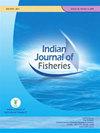阿拉伯海的深海泥虾和铲鼻龙虾是长链多不饱和脂肪酸的潜在来源
IF 0.3
4区 农林科学
Q4 FISHERIES
引用次数: 3
摘要
对从印度西南海岸(阿拉伯海)捕捞的深海泥虾(Solenocera hextii)和铲鼻龙虾(Thenus unimaculatus)的脂肪酸图谱进行了评估和比较。棕榈酸和油酸分别是龙虾和虾类的主要饱和脂肪酸和单不饱和脂肪酸。单刺T.unimaculatus含有更高浓度的C20-22n-3多不饱和脂肪酸,如二十二碳六烯酸和二十碳五烯酸。与泥虾相比,铲鼻龙虾的n-3/n-6多不饱和脂肪酸比率更高(大于4),多不饱和/饱和脂肪酸(>1.2)和低胆固醇/高胆固醇比率(>2)也明显更高。较低的血栓形成性(≤0.5)和动脉粥样硬化形成性(<1.0)指数表明,单刺T.unimaculatus是人类营养理想的海洋物种。本文章由计算机程序翻译,如有差异,请以英文原文为准。
Deep-sea mud shrimp and shovel-nosed lobster from the Arabian Sea as prospective sources of long-chain polyunsaturated fatty acids
Fatty acid profile of deep-sea mud shrimp (Solenocera hextii) and shovel-nosed lobster (Thenus unimaculatus) harvested
from south-west coast (Arabian Sea) of India were evaluated and compared. Palmitic and oleic acids were the principle
saturated fatty acids and monounsaturated fatty acids, respectively in lobster and shrimp species. T. unimaculatus contained
greater concentrations of C20-22 n-3 polyunsaturated fatty acids, such as docosahexaenoic acid and eicosapentaenoic acid.
Higher n-3/n-6 polyunsaturated fatty acid ratio (greater than 4) in addition to considerably greater polyunsaturated/saturated
fatty acid (>1.2) and hypocholesterolaemic/hypercholesterolaemic ratio (>2) were recorded in shovel-nosed lobster
compared to the mud shrimp. Lesser thrombogenicity (≤0.5) and atherogenicity (<1.0) indices recognised T. unimaculatus
as a desirable marine species for human nutrition.
求助全文
通过发布文献求助,成功后即可免费获取论文全文。
去求助
来源期刊

Indian Journal of Fisheries
FISHERIES-
CiteScore
0.90
自引率
20.00%
发文量
0
审稿时长
6-12 weeks
期刊介绍:
Indian Journal of Fisheries is published quarterly by the Indian Council of Agricultural Research (ICAR), New Delhi. Original contributions in the field of Fish and fisheries science are considered for publication in the Journal. The material submitted must be unpublished and not under consideration for publication elsewhere.
Papers based on research which kills or damages any species, regarded as thratened/ endangered by IUCN crieteria or is as such listed in the Red Data Book appropriate to the geographic area concerned, will not be accepted by the Journal, unless the work has clear conservation objectives.
 求助内容:
求助内容: 应助结果提醒方式:
应助结果提醒方式:


